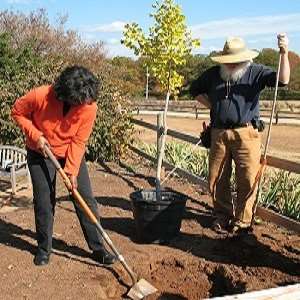By Merritt Melancon
It’s Arbor Day again, and that means it’s time for Georgians interested in adding trees to their landscape to get those trees in the ground.

Georgia’s springs often seem to sneak up on the state. With intense warm and dry periods possible in March, University of Georgia Cooperative Extension horticulturists urge Georgians to go ahead and plant their new trees, especially if they live in the southern half of the state.
“We have seen spring temperatures warm up quickly in some years,” said Sheri Dorn, coordinator of UGA’s Master Gardener Extension Volunteer program and UGA Extension consumer ornamental specialist. “That really doesn’t give spring-planted trees much time to establish and take root in the soil before being stressed by weather that can be hot and dry. So we want to plant early if we’re planting in the spring.”
Dorn actually prefers to plant trees and shrubs in the fall, when soil temperatures are still warm, but daytime temperatures are cooling. These conditions give fall-planted trees and shrubs more time to establish a root system that can help them weather the challenges of spring and summer.
However, she said, it’s not too late. Trees and shrubs can be planted at almost any time of year as long as the gardener keeps the plants watered. She has a few tips to help Georgia gardeners make the most of their Arbor Day tree-planting plans.
Pick the right tree.
Many trees will grow in Georgia, but there is a select group that will really thrive here despite the hot summers, dry spells and quirky weather shifts.
Dorn advises homeowners to do some research before sinking money into a new tree. UGA Extension offers a guide to landscape trees that have been proven to flourish in Georgia. An electronic copy of “Landscape Plants for Georgia” is available for free at extension.uga.edu/publications/detail.cfm?number=B625 or through extension.uga.edu/publications.
“There are so many wonderful, underutilized, small trees that homeowners can choose for their yard if they want the height and the vertical appeal of a tree, but they don’t have space for a large tree,” Dorn said. “Doing a little research and finding out more about the right tree for your landscape will help the tree thrive.”
Popular trees like dogwoods, Japanese maples and redbuds do better with some shade. Homeowners usually plant them directly in the middle of their yards, in full, direct sun. Planting a shade-favoring tree in full sun can stress the tree and can lead to insect or disease issues, Dorn said.
Dig a hole.
The most common mistake that people make when planting a new tree is planting it too deep, Dorn said. While digging a hole for a new tree seems simple, it actually takes thought.
The basic rule of thumb is that the hole should be twice as wide as the tree base, and deep enough so that the top of the rootball is at or just above the surface of the surrounding soil. Firm the soil around the roots without compacting it.
The tree will settle after you plant it, and you don’t want the top of the rootball to sink below the ground after watering it, Dorn said. Check the level of the rootball after watering the tree for the first time to make sure that it hasn’t settled below the soil surface.
Spread pine straw or other mulch around the base of the tree and over the planting area, taking care not to pile it against the tree trunk. Mulch will keep roots cool and reduce the chance of damage to the trunk by lawn mowers or string trimmers.
Prior to planting, check the site for drainage. Once you’ve dug the hole, Dorn suggests filling it with water. If it holds water for more than 24 hours, find another place to plant the tree, or find a tree that doesn’t mind “wet feet.” Putting a tree that likes well-drained soil in a soggy spot is just asking for heartbreak.
Water, water, water
One of the major reasons that new trees fail is a lack of water. Most people know that newly planted trees need a lot of water to help establish a healthy root system, but many stop paying special attention to the tree after the first few months. New trees take about three years to become fully established, and they’re very vulnerable in the first year after they’re transplanted.
Landscape plants need about an inch of water a week. If you’re not getting an inch of rain a week, it’s time to pull out the garden hose.
Trees need to be watered deeply to help promote healthy root systems. Trees grown and bought in containers may need water several times per week, while trees with soil rootballs may need water only once a week. For homeowners without irrigation systems, Dorn recommends setting the water so that only a trickle is coming out of the end of the hose, then parking the hose right on top of the new tree’s rootball. Leave the dripping hose in that spot for about 30 minutes once or twice a week so that the water soaks into the soil.
Source: uga.edu